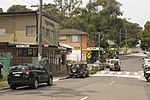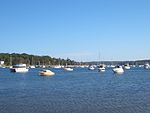Wedding Cake Rock

Wedding Cake Rock, also known as White Rock, is a sandstone rock formation located in the Royal National Park near Bundeena in Sydney, New South Wales, Australia, accessible via the Royal National Park Coast Track. The rock is one of many formations that appear north of Marley Beach, and is suspended 25 metres (82 ft) above sea level. Wedding Cake Rock is noted for its scenic location and popularity with bushwalkers and tourists, as an attractive location for photography. Its reputation, however, was damaged after the landmark saw a sudden spike in popularity in 2015, and subsequently fell victim to vandalism. The rock was closed off from public access in May 2015 by the New South Wales National Parks and Wildlife Service, citing the dangerous behavior of recent visitors, and later, safety concerns, after a survey conducted the following month determined that the rock was unstable, and that it would collapse into the Tasman Sea within the next decade.
Excerpt from the Wikipedia article Wedding Cake Rock (License: CC BY-SA 3.0, Authors, Images).Wedding Cake Rock
Big Marley Fire Trail, Sutherland Shire Council
Geographical coordinates (GPS) Address External links Nearby Places Show on map
Geographical coordinates (GPS)
| Latitude | Longitude |
|---|---|
| N -34.109666666667 ° | E 151.15241666667 ° |
Address
Wedding Cake Rock (White rock)
Big Marley Fire Trail
2232 Sutherland Shire Council, Royal National Park
New South Wales, Australia
Open on Google Maps









